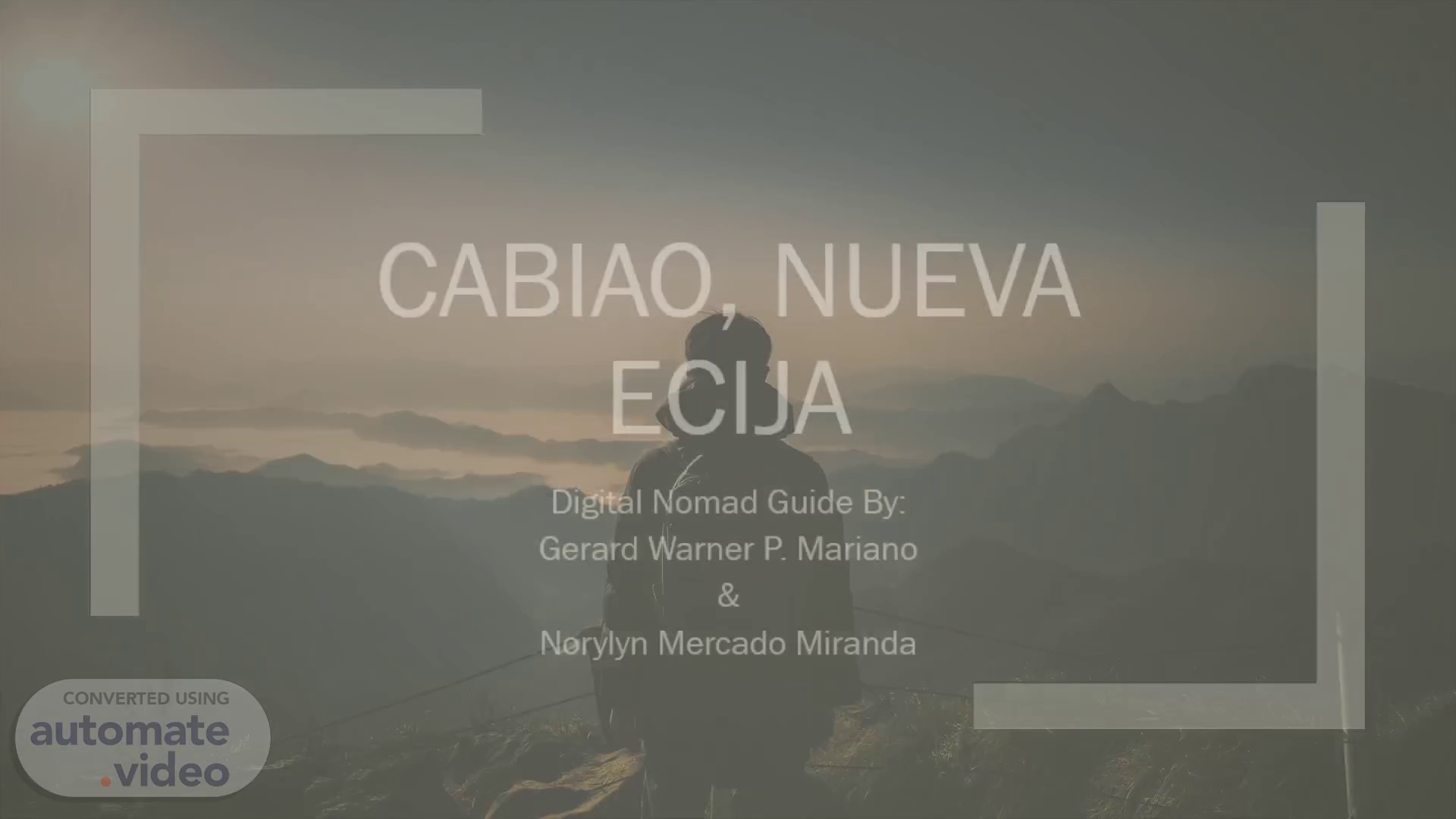Scene 1 (0s)
[Audio] Hi guys we are the MRES 201 Cabiao group and we are here to talk about the wonders and festivals of Cabiao nueva ecija..
Scene 2 (11s)
[Audio] Cabiao is a first-class municipality in the province of Nueva Ecija, located in the central part of Luzon Island in the Philippines. The town has a rich history that dates back to the Spanish colonial period and has since evolved into a progressive municipality.
Scene 3 (29s)
[Audio] Short History of Cabiao. Short History of Cabiao.
Scene 4 (35s)
[Audio] Cabiao derived its name from its vandalized Malay origin kabyawan (gilingan[same Malay meaning]) in previous Malay form: karyawan- meaning writer at present) meaning grinding tools that used for crushing. The abundance of sugar during the pre-Spanish era is evident in a wide area of kabyaw including the area going to the foot of Mount Arayat. The kabyawan became familiar to the neighboring places due to the concentration of kabyawan in the place where it was located and was identified as Kabyawan and later shortened to "Kabyaw" and eventually altered the spelling due to the influence of the foreign alphabet letters. The used of kabyawan then is prevalent among the natives constituting mainly the ancient tribes of tagalogs that hails from Bulacan and capampangan of which they came in waves of migration from mainland Malay origin as evident from their language similarity..
Scene 5 (1m 30s)
[Audio] Cabiao as termed today was a just balangay of the once prosperous of empire of the campampangan settlement named Candaba, as it was discovered by the exploring Spanish conquistadores in 1590. The visita of Cabiao was perhaps established somewhere between 1765 and 1767 by the Jesuit Missionary before they were sent back to Spain under the order of King Charles III of Spain to recall all the Society of Jesus religious order to return to Spain thereby banishing them from all the Spanish dominions. Cabiao gain its full township of Pampanga in 1797 under the term of Governor General Rafael Maria de Aguilar y Ponce de Leon* with the recommendation of the returning order of the Augustinian in the Province of Pampanga and elevates the Visita of St. John Nepomucene that was established by the Jesuits into a regular Parish Church. It was established as one of the municipality of Nueva Ecija in February 9, 1848 upon the order issued by Governor General Narciso Claveria Y Zaldua and upon the thorough evaluation and recommendation made by the Governor General Marcelino Oraa. The growth of Cabiao during that time maybe attributed to its vast marsh and inland water that serves as inland fishery of the area. The Poblacion comprising the three pillars of Spanish governance of the Spaniard namely the Casa Municipal, Casa dela Iglesia and Casa Judicial were erected in 1838 under the term of Don Josef Kabigting as the Gobernadorcillo (the present location of the church, the central school and the intervening residential area between the central school and the church)..
Scene 6 (3m 6s)
[Audio] Festivals in Cabiao Nueva Ecija Cabiao, Nueva Ecija, is known for its colorful festivals and fiestas, which showcase the town's rich cultural heritage. Here are some of the significant events and fiestas that happen in Cabiao throughout the year: Feast of Our Lady of Lourdes - This feast is held every February 11 to honor Our Lady of Lourdes. The celebration includes a procession, a holy mass, and a grand fiesta that features food, games, and entertainment.
Scene 7 (3m 40s)
[Audio] Carabao Festival - This festival is held every December in honor of the carabao, which is considered a symbol of strength and hard work in the town. The festival features a carabao parade, a carabao race, and various cultural presentations..
Scene 8 (3m 57s)
[Audio] Kabyawan Festival – The event is celebrated every year as a form of thanksgiving like many other festivals in the province. The name "kabyaw" originated from the term "kabyawan", the name of a stone device operated by means of a carabao and which was used to crash sugar cane to get the juice which is use in the production of molasses, sugar and others Through the years, the Kabyawan Festival has grown to become one of the most popular events in Cabiao, attracting visitors from different parts of the province and beyond. The festival has evolved to include various activities such as street dancing and cultural presentations, The Kabyawan Festival is not only a celebration of the town's agricultural bounties but also a way to promote sustainable development and environmental awareness. Today, the Kabyawan Festival is a symbol of the town's identity and a source of pride for its people, who continue to uphold and promote their cultural traditions while embracing progress and innovation. These events and fiestas in Cabiao, Nueva Ecija, not only showcase the town's rich cultural heritage but also promote tourism and encourage community bonding..
Scene 9 (5m 11s)
[Audio] Paistima Ka sa Kabyawan Festival, a week-long festivity every first/second week of February. The festival commemorates the founding anniversary of the town that showcases the rich culture and display the wide array of local delicacies. The acronym "PaIsTiMa Ka" is from: Pa (Palay), Is (Isda), Ti (Tinapay), Ma (Mangga), and Ka (Ikaw)..
Scene 10 (5m 40s)
[Audio] Cabiao Floating Market This floating market similar to the one in Thailand. The Cabiao Floating Market is claimed as the first of its kind in the Philippines..
Scene 11 (5m 53s)
[Audio] Thank you. Thank you.
